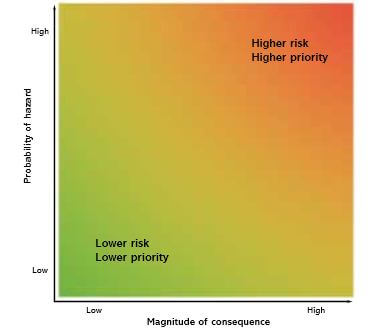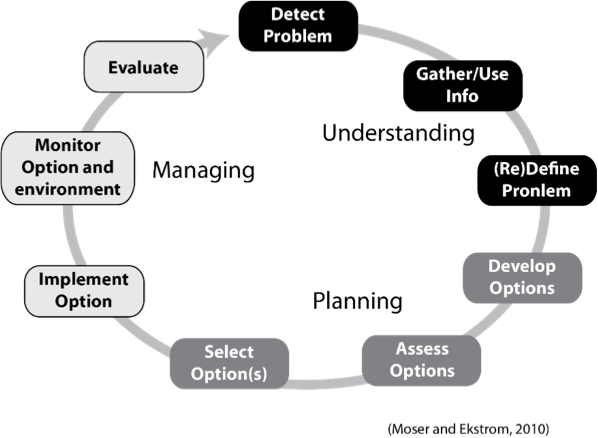Adaptation & uncertainty
Key information
All decisions made to realise some kind of benefit in the future are uncertain. Planning for future climate change is similar and involves making decisions under uncertainty regarding the extent of future climatic changes. However, as adaptation problems do not occur in isolation, uncertainty also exists regarding future social, demographic, political and economic change. In contrast to approaches that seek to develop an optimal plan, adaptation does not require precise foresight of the future.
Adaptation decision-making does not require precise foresight of future change, and uncertainties do not prevent planned/anticipatory adaptation.
Uncertainty describes the quality of our knowledge of risk. Risk is commonly defined as the product of the probability or likelihood of occurrence of a hazard and the magnitude of consequence. As a result, uncertainty may relate to either the probability or consequence components of risk - UKCIP, 2003
- Climate change will affect the outcomes of many long-term development decisions;
- Climate change is not just an additional risk that can be managed separately but has affects for many, if not all, long-term strategies and initiatives. These can be considered as climate-sensitive;
- The extent of future climate change is determined by ongoing and future levels of emissions of GHGs and is dependent upon future social, demographic, political and economic change, all of which are uncertain;
- Uncertainty is evident in all decisions that are designed to bring some future benefit to something or someone;
- Tackling climate change and uncertainties will require a forward-looking, pro-active, flexible approach to programming;
- Adaptation is the only way to protect gains in development from the unavoidable impacts of climate change. Rather than looking for optimal solutions, planning for climate change requires robust and flexible approaches which can incorporate new learning and experience;
- Adaptive management is useful in the context of climate change where uncertainty exists and aims to supporting decision-making in the long term by reducing uncertainty through time.
Detailed explanation
All decisions made are intended to realise some form of future benefit. Without uncertainty, such decisions would be straightforward. However, in reality, decision making is rendered complex by the need to make judgements regarding unknown future conditions.
Uncertainty describes the quality of our knowledge of risk. Risk is commonly defined as the product of the probability or likelihood of occurrence of a hazard and the magnitude of consequence. As a result, uncertainty may relate to either the probability or consequence components of risk [ref].
In planning for future climate change, uncertainty exists regarding future climatic changes. In addition, because adaptation problems do not occur in isolation, uncertainty also exists regarding future social, demographic, political and economic change.

Risks that have a high probability of occurrence with potentially high consequences are deemed high risk while those with a low probability of occurrence and potentially low consequences are deemed low risk.
Decision-making for climate adaptation
In contrast to approaches which seek to develop an optimal plan focussed on a narrowly defined set of circumstances, adaptation decision-making does not require precise foresight of future change, and uncertainties do not prevent planned/anticipatory adaptation. This is because outcomes from adaptation decision-making are ultimately not only determined by what is known or anticipated at present but also by our future learning, experience and responses. As such, adaptation decision making aims to develop plans that are robust and flexible.
Robust and Flexible Approaches to Decision Making
Robust Decision Making employs multiple views of the future to support a thorough evaluation of the full range of potential vulnerabilities and opportunities. For example, instead of planning for a dam that will have a 100 year lifespan and will fulfil its purpose under a prescribed set of conditions, a robust strategy identifies the full range of possible futures and then seeks strategies that will perform well over a wide range of alternative futures.
Flexible Approaches to adaptation comprise those where decisions are made over time to continuously and incrementally adapt to change while maintaining future flexibility. Flexible approaches also serve to facilitate robust planning practises by avoiding lock-in, i.e. when policy is placed on an unchangeable pathway as the result of a one-off adaptation decision that cannot be revisited.
Adaptive Management
Adaptive Management is an approach to management where all decision making is to some extent experimental and is therefore open to revisitation and revision as new information becomes available and new knowledge is gained. The process is often described as "learning as we go".
Adaptive Management is useful in the context of climate change where uncertainty exists and aims to supporting decision-making in the long term by reducing uncertainty through time. This is achieved by employing a structured iterative approach that involves monitoring, evaluation and adjustment of actions based on what has been learned.

Adaptive management allow for adjustment of plans based on new learning and experience and involves a process of continuing phases of assessment, design, implementation, monitoring and adjustment [source: Moser & Ekstrom, 2010].
- Understanding: This phase involves problem detection and awareness raising and results in an initial framing of the problem for the area under investigation. Following from this, information is gathered to deepen understanding of the problem, which is then redefined and objectives of the plan are specified;
- Planning: This phase involves the identification of adaptation options, assessment of these options in relation to the specified objectives, and selection of preferred options;
- Management: This phase involves the implementation of the selected options, monitoring to assess whether the outcome of the option is realised and evaluation. Monitoring and evaluation are critical as they help to support institutional and social learning which is commonly considered necessary to deal with complex and uncertain problems.
Resources
- Climate-Adapt (European Climate Adaptation Platform): Uncertainty Guidance: This guidance aims to help decision makers in understanding the sources of uncertainty in climate information that is most relevant for adaptation planning.
- Adapt or Perish: A Review of Planning Approaches for Adaptation under Deep Uncertainty: This academic review compares planning approach for adaptation to climate change and describes some of the tools that support them.
- Climate adaptation: Risk, uncertainty and decision-making: Produced by the UK Climate Impacts Partnership, this report recommends a structured framework to enable decision-makers to recognise and evaluate risks posed by climate change, making the best use of available information about climate change, its impacts and appropriate adaptive responses.
- EEA report: Adaptation in Europe: This report provides policymakers across Europe, at different levels of governance and stages of policy formulation, with information that can be used to support adaptation planning and implementation. Specific parts of the report are therefore targeted at different audiences.
- Weathering the Storm: Options for Framing Adaptation and Development: World Resources Institute 2003 report on different frameworks for adaptation and development – reviewing adaptation efforts drawn from throughout the developing world.
